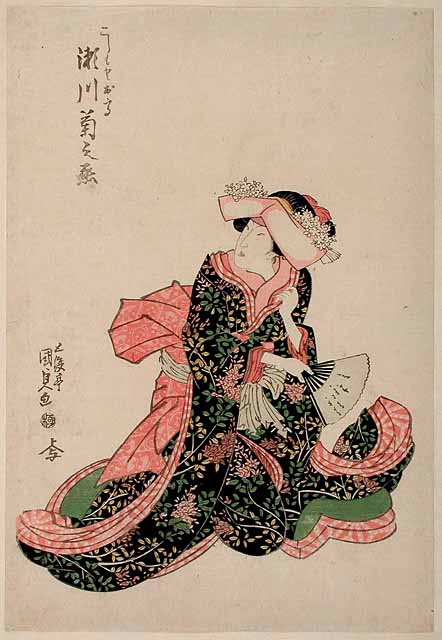
Segawa Kikunojo V as Koshimoto Otaka in the play Shiire Soga Karigane-zome
Segawa Kikunojo V as Koshimoto Otaka in the play Shiire Soga Karigane-zome (A new Soga Brothers design dyed in the Karigane Gang style) performed at the Nakamura Theatre in 01/1820
Private collection
This print is probably part of a triptych. It depicts a scene from one of the many plays performed at New Year based on the popular story of the revenge of the Soga brothers, in this case with a plot connected to that of the plays based on Karigane gonin otoko (Karigane’s ‘Five Chivalrous Men’ Gang), the story of the outlaw Karigane and his gang.
Loan 272
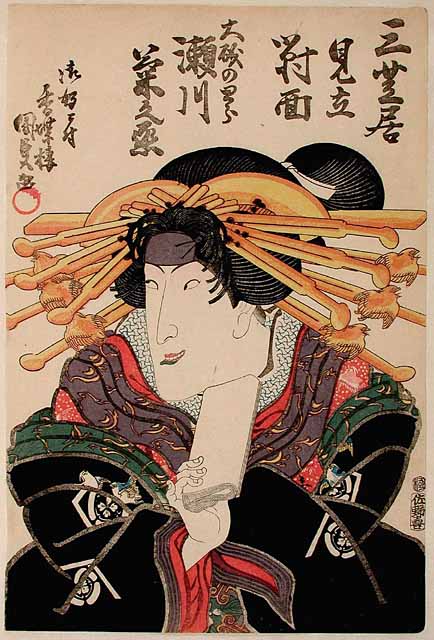
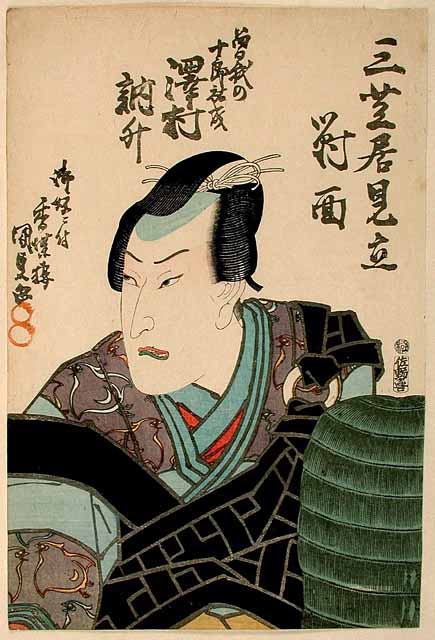
Segawa Kikunojo V as Oiso no Tora Gozen (right) and Sawamura Tossho I as Soga no Juro (left)
Segawa Kikunojo V as Oiso no Tora Gozen (right) and Sawamura Tossho I as Soga no Juro (left) in Kotobuki Soga no taimen (The Soga Brothers Confrontation c. 1831/2
Private collection
From the set An Imagined Confrontation of the Three Theatres (San shibai mitate taimen), which shows the leading actors of the three competing Edo theatres as the cast for an imagined performance of the most popular of all Kabuki revenge tales. Soga no Juro is paired in this set with his mistress Oiso no Tora Gozen. The hero is shown wearing a monks robe and holding a monks hat. His kimono is decorated with the same flying-plovers pattern as his mistresss. Tossho I (later called Gennosuke II) was noted for his skill in portraying refined young men.
This portrait combines his elegant bearing with a sense of his grim determination to be revenged. The role of Juros mistress was in the popular category of steadfast courtesan. It allowed the female-role actor to display the breadth of his acting ability in lyric passages, scenes of amorous dalliance, gentle solicitude, grim determination and farce. Kikunojo V wears the full robes and luxurious hair ornaments of a courtesan. His pose is flirtatious, with the bundle of tissues representing an invitation to erotic dalliance. This was probably the last print of Kikunojo to be issued before his death in 01/1832 at the age of 30.
Loan 271 & 310
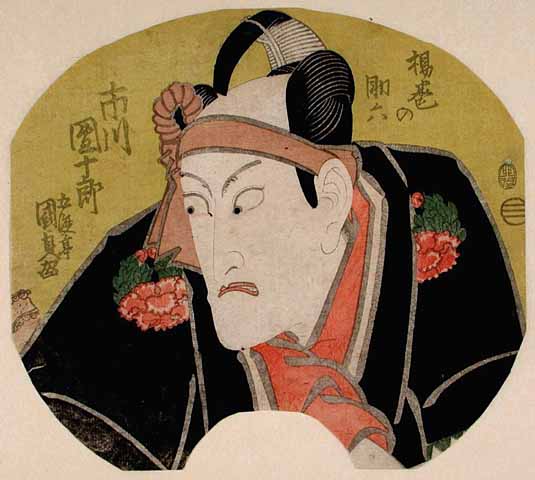
Ichikawa Danjuro VII
Kunisada 14
Ichikawa Danjuro VII as Sukeroku in Sukeroku yukari no Edo zakura (Sukeroku’s affinity for the cherry blossoms of Edo) performed at the Tamagawa Theatre in 1819; Private collection
Loan 405
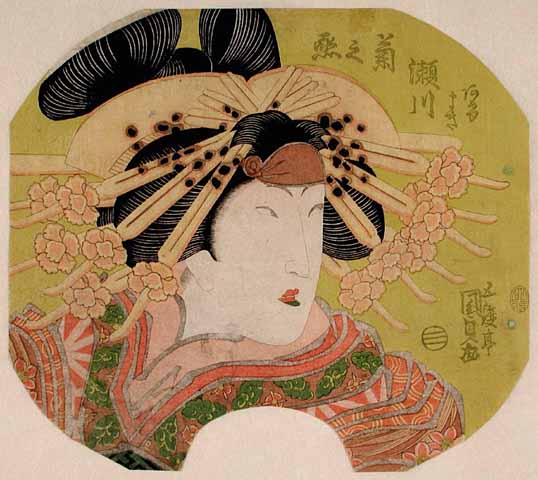
Segawa Kikunojo V as Agemaki in Sukeroku yukari no Edo zakura
Sukeroku’s affinity for the cherry blossoms of Edo performed at the Tamagawa Theatre in 1819.
Private collection
You can read a more detailed description as part of this text.
Loan 406
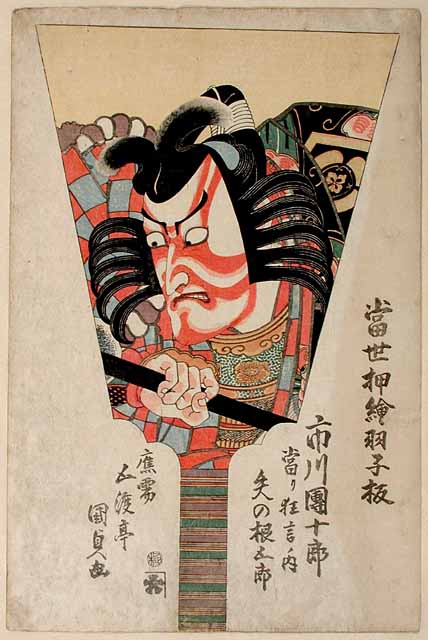
Ichikawa Danjuro VII as Soga no Goro c. 1823
Private collection
From the set of nine designs entitled Tosei oshi-e hagoita atari kyogen no uchii (Modern cloth-picture battledores stage hits).
Danjuro VII is depicted as Soga no Goro in Yanone (The arrow-sharpener), one of the popular plays based on the story of the revenge of the Soga brothers on their father’s murderer, Suketsune. This virtuoso role was performed in the most extravagant ‘rough stuff’ (aragoto) style of acting developed by the Danjuro lineage of actors. It allowed Danjuro VII to display his mastery in the portrayal of swash-buckling heroes. The striking face-paint, which is typical of such heroic roles, expresses the intensity of the character’s feelings. In this instance the hero, burning with rage, sharpens a double-tipped arrow with which he and his brother intend to avenge their father’s murder.
Loan 479
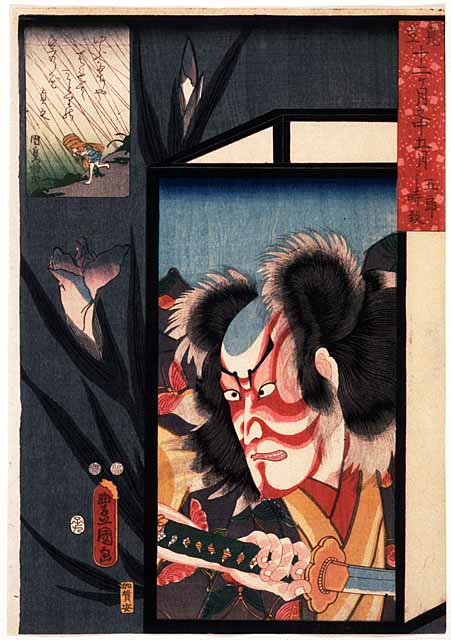
Gogatsu Goro Tokimune (Fifth Month: Goro Tokimune)
Kunisada 39
09/1852
Given by the Friends of the Fitzwilliam with the aid of the MGC Purchase Grant Fund and the National Art Collections Fund.
Portrait of Ichikawa Danjuro VIII as Soga no Goro, from the series Mitate juni-ka-getsu (Comparisons with the Twelve Months).
The portrait is depicted as though the face is painted on a lantern, and is accompanied by an inset designed by Kunisada II (1823-80) showing a figure running in a sudden evening shower. Plays telling of the revenge taken by the Soga no Goro and his brother Soga no Juro on their father’s murderer were traditionally performed at New Year, but there were also quick-change dance pieces (henge mono) devoted to single characters, which were performed at other times of year. One of these was Ame no Goro (‘Rainfall Goro’) or Tokimune first created in 1841 for a festival honouring the Soga brothers.
Its story involves Goro’s visit to the pleasure quarters to visit his mistress during a rain-storm. He wears a richly-embroidered robe with the butterfly motif associated with the character, and the sort of red make-up (beni guma) and wild-haired wig typical of the aragoto (‘rough-stuff’) roles specially associated with the Ichikawa lineage of actors.
Each actor in this series is matched with a month; the connection in this print may be that the revenge in the Soga story took place in the fifth month. The iris is the symbol of the Fifth Month.
Collections Record: P.61-1999
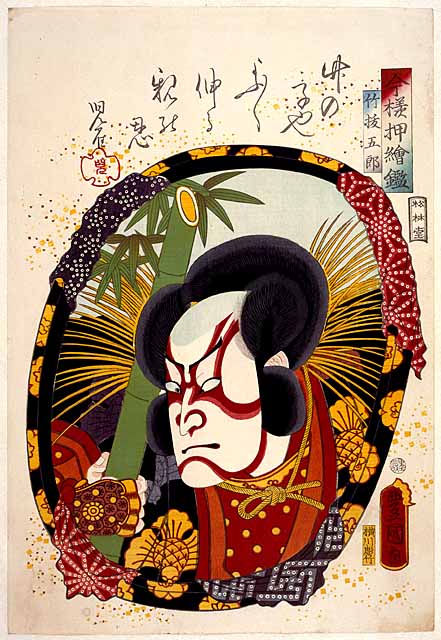
Nakamura Fukusuke I as Soga no Goro in Yayoi-zakura hisago no makubari , performed at the Nakamura theatre from 09/03/1860
Kunisada 58
Given by the Friends of the Fitzwilliam with the aid of the MGC Purchase Grant Fund and the National Art Collections Fund.
From the series Imayo oshi-e kagami (Up-to-date Padded Pictures in Mirrors). Kunisada designed several series of portraits of actors reflected in mirrors. Six prints from this series are included in this exhibition.
This print of ‘bamboo-tugging Goro’ illustrates the scene in this Spring play (yayoi kyogen) in which the dance skit Edo-ganoko ninin Dojo-ji is performed.
The printing includes burnishing (tsuya-zuri) on the black. The seal of the leading block-carver Yokokawa Takejiro appears on the print.
Collections Record: P.81-1999
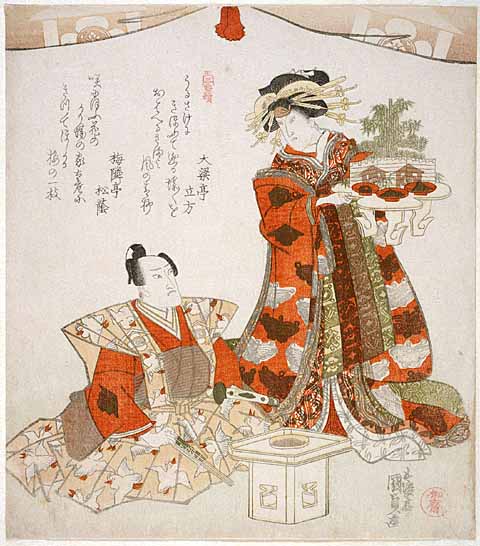
Iwai Kumesaburo II as Oiso no Tora bringing food to Soga no Juro, played by Onoe Kikugoro III
Kunisada 70
c. 1818-20
Given to the Fitzwilliam Museum by E. Evelyn Barron in 1937
From a set of five surimono commissioned for the Hisakataya poetry group whose emblem, a stylised koto bridge, surmounts the red inscription: Goban-tsusuki (from a set of five). The printer’s seal of Ryusai Chimata (Ino Naojiro) also appears on the print. The set depicts characters from the cycle of plays telling of the revenge of the two Soga brothers, Soga no Juro and Soga no Goro, on their father’s murderer Kudo Suketsune.
The Iori-mokko motif (a magnolia within a stylised hut) associated with Kudo Suketsune decorates the curtain looped across the top of all five prints in the series. It also occurs on the curtain on the Shimadai (island tray) decoration held by Oiso no Tora in this print. The motif alludes to Suketsune’s hunting lodge at Susono below Mount Fuji, where he was finally murdered by the Soga brothers. Soga no Juro’s costume bears the pattern of flying-plovers (chidori) that was traditionally associated with him, while his sleeve is decorated with the Yamagata-mokko motif of Soga. His mistress Tora’s costume is decorated with a Soga butterfly motif, which was also associated with the actor Kumesaburo
Collections Record: P.498-1937
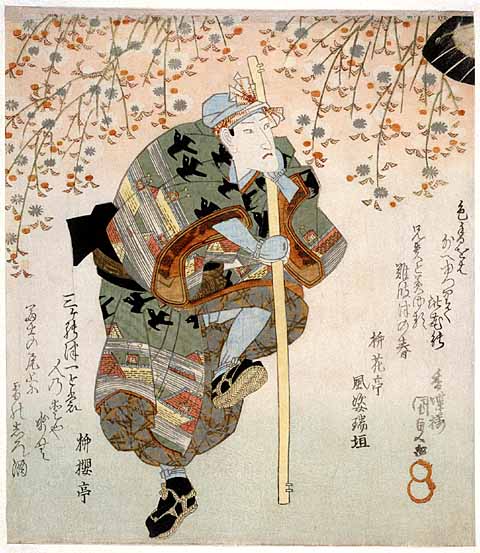
Onoe Kikugoro III as Shimbei
Collections Record: P.502-1937
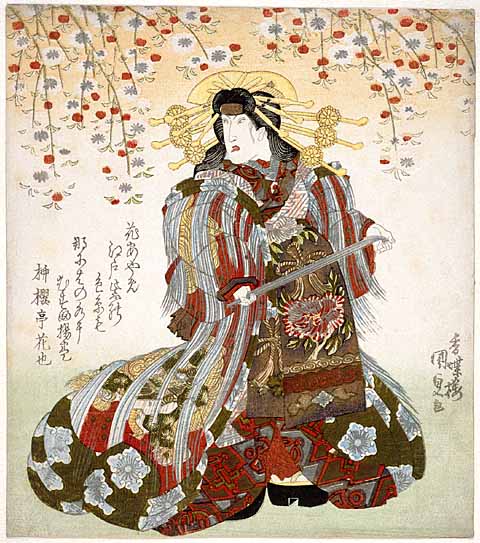
Iwai Kumesaburo II as Agemaki
Collections Record: P.501-1937
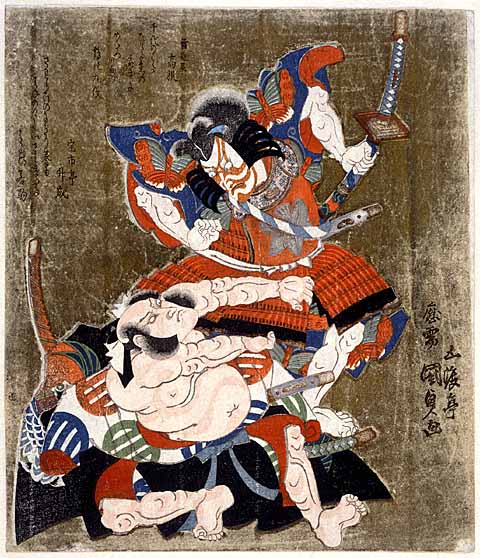
Ichikawa Danjuro VII as Soga no Goro and Bando Mitsugoro III as Asaina no Saburo in the armour-pulling scene (kusazuribiku)
Kunisada 81
1827 Given to the Fitzwilliam Museum by E. Evelyn Barron in 1937
A surimono of the famous armour-pulling scene (kusazuribiki) which had become a highpoint of various Kabuki plays telling of the revenge of the two Soga brothers, Soga no Juro and Soga no Goro, on their fathers murderer Kudo Suketsune. Soga no Goro, believing his brother to be in mortal danger, rushes out from hiding to his defence, only to be held back by the legendary strongman warrior Asaina no Saburo (1176-?) tugging at the skirt of his armour. Goro was said to have held his ground like a guardian statue. This print probably depicts an imaginary performance of a Soga brothers vendetta play, as these actors did not appear in these roles in 1827.
Danjuros costume bears the Soga butterfly crest, while his sword-hilt is decorated with the Ichikawa acting crest (mon) of three concentric boxes, or triple-rice-measure (mimasu). Mitsugoros acting crest (mon)a circle containing the triple-stroke character for threedecorates his costume.
The first poem puns on the verb hikeru, which can refer either to trailing mists or tugging. The other poem likens the curling leaves of springtime bracken ferns to clenched fists.
Collections Record: P.503-1937
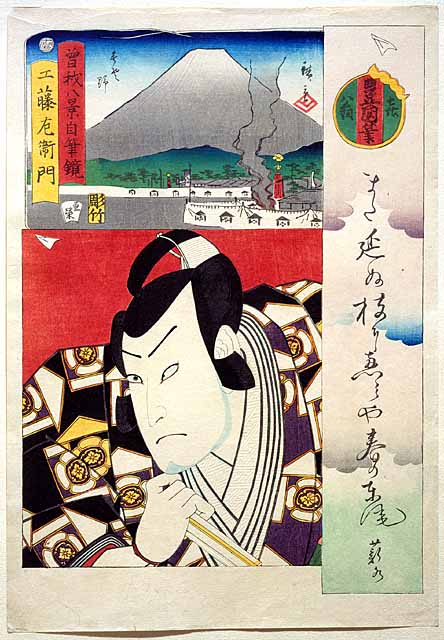
Bando Hikosaburo V as Kudo Saemon in Sano kei zu Soga no gosho-zome (A Sano lineage Soga of courtly hue) performed at the Nakamura theatre from 01/1862
Kunisada 63
Given by David Scrase 1994
Published in 12/1861 as part of the series Tosei jihitsu kagami (Mirror of Contemporary Autographs).
From the series Tosei jihitsu kagami (Mirror of Contemporary Autographs), published 12/1861, with portraits by Kunisada juxtaposed against landscapes or still-lifes designed sometimes by Hiroshige or (in this case) by his pupil Ichiyusai Shigenobu, known as Hiroshige II (1826-69).
This print was evidently intended as advance publicity for the appearance of Bando Hikosaburo in this role at the Nakamura theatre in New Year of 1862. A New Year hokku poem, signed in imitation of the actor’s own calligraphy, appears down the right on the tanzaku (long poem card):
A blessing to the branches which still do not sprout the east wind of spring.
Collections Record: P.113-1994
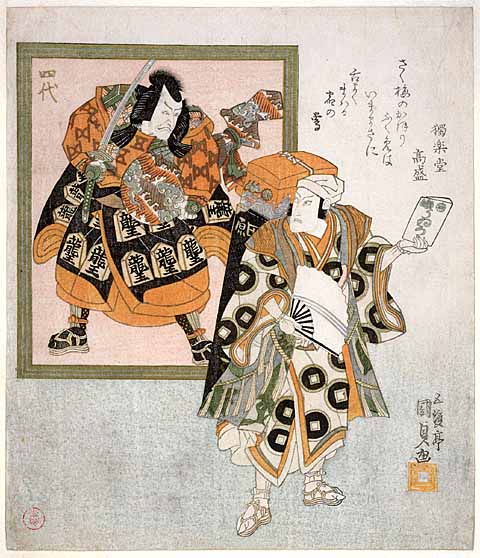
Ichikawa Danjuro VII as a medicine seller in front of a cartouche of Danjuro IV as Kagekiyo
Kunisada 71
Given to the Fitzwilliam Museum by E. Evelyn Barron in 1937
This surimono is sealed beneath Kunisada’s signature with the artist’s sada seal in the form of the mimasu (triple-rice-measure) box which was the Ichikawa lineage acting crest (mon). It also bears the production seal of Kubo Shumman (1757-1820), indicating that Kunisada’s design was cut and printed by the Shumman studio. It was commissioned by the Go poetry group, whose stylised symbol made up of the character for ‘five’ (go) is used as the pattern on the upper part of Danjuro IV’s outer robe.
The surimono may have been intended as a memorial to Danjuro IV, and celebrates roles which were specialities of the Ichikawa lineage of actors. Kagekiyo was revived and revised by Danjuro IV and included by Danjuro VII in his selection of Eighteen Plays (Kabuki Juhachiban) specially associated with the Ichikawa lineage. The Ichikawa mimasu crest (mon) is seen on the hilt of Danjuro IV’s sword. He holds in a bag the precious biwa (lute) called Seizan, which Kagekiyo is hiding from his Genji enemies.
Danjuro VII is shown in the foreground holding a fan in one hand, which is embossed with the silver triple stripe (misuji) associated with the Ichikawa lineage. In the other hand he holds a medicine packet bearing the character uira[u], referring to the medicine uiro, which was supposed to cure everything from constipation to bad breath. The larger black case on his back has the characters for [O]dawara, the place where the medicine was produced. Uiro sellers were famous for their high-pitched voices and rapid sales-talk. Danjuro II, celebrated for his elocution, incorporated a uiro seller into a play on a Soga theme in 1718 (Wakamidori ikioi Soga), in which he is actually Soga no Juro in disguise. Danjuro VII wears the costume associated with this role: decorated with lucky coins and with a lining motif of sacred shimenawa ropes and dangling paper streamers. He later incorporated the role into a performance of Sukeroku yukari no Edo zakura (Sukeroku’s affinity for the cherry blossoms of Edo), in which he passed the Danjuro name onto his ten-year-old son, who became Danjuro VIII.
The poem on the surimono by Dokurakudo Takamori weaves into a standard New Year kyoka an allusion to the famed verbal gymnastics of the uiro seller, which in the play were supposedly due to the piece of uiro that he had put into his mouth:
Saku ume no With the scent of plum kaori fukumeba blossoms filling its mouth,ima masa ni the warbler in the courtyard shita yoku mawaru is now readied to recite yado no uguisu its elegant tongue-twisters.
(translation by John Carpenter)
Collections Record: P.493-1937



